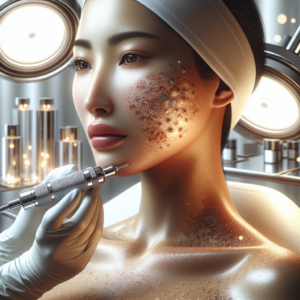Microneedling, a buzzword in the skincare world, might seem like a brand-new technique, but did you know it has deep historical roots? Imagine this process as a way of encouraging your skin to rejuvenate naturally, much like how aerating a lawn helps it grow healthily. Let’s take a journey through time to explore the fascinating evolution of microneedling—from its ancient origins to the high-tech devices dermatologists use today.
Contents
- 1 The Ancient Beginnings of Microneedling
- 2 The Renaissance of Skin Treatments in the 20th Century
- 3 The Science Behind Microneedling’s Success
- 4 Modern Microneedling Devices and Their Impact
- 5 The Versatility of Microneedling in Skincare
- 6 Considerations and the Future of Microneedling
- 7 FAQs About Microneedling
The Ancient Beginnings of Microneedling
Long before modern beauty tools graced our shelves, ancient cultures were already discovering the secrets to vibrant skin. In traditional Chinese medicine, techniques similar to microneedling were used centuries ago. They involved using fine needles to stimulate specific points on the body, enhancing both health and appearance.
Similarly, ancient Egyptians are famed for their innovative beauty practices. Known for seeking eternal youth, they utilized methods to exfoliate and treat their skin, laying the groundwork for what we now recognize as microneedling.
The Renaissance of Skin Treatments in the 20th Century
Fast forward to the early 1900s, and we see the emergence of modern dermatological practices. In 1905, a German dermatologist named Dr. Ernst Kromayer paved the way by using very fine needles for scar treatment. This marked a significant advancement, as Kromayer’s methods were the precursor to today’s microneedling techniques.
In the decades that followed, the journey of microneedling continued to evolve. By the late 1990s, Dr. Des Fernandes, a South African plastic surgeon, took microneedling to the next level. He invented a needling device specifically to increase collagen production—a protein vital for skin elasticity and firmness. This led to the development of the dermaroller, a handheld device covered in hundreds of tiny needles designed to create controlled micro-injuries on the skin.
The Science Behind Microneedling’s Success
You might be wondering, “How does creating tiny injuries help my skin?” The answer lies in the skin’s natural healing process. When the skin detects these micro-injuries, it rushes to repair them by producing more collagen and elastin. Think of it as jumpstarting your skin’s engine, encouraging it to rejuvenate.
This principle of “collagen induction therapy,” as it’s formally known, makes microneedling a go-to treatment for improving skin texture, reducing acne scars, and even minimizing fine lines and wrinkles. If you’ve heard about microneedling’s benefits for acne scars, that’s why it’s becoming increasingly popular for those concerns.
Modern Microneedling Devices and Their Impact
Today, microneedling has transformed from a simple roller to sophisticated electronic devices. The dermapen, for instance, is a modern advancement that offers precision and depth control, allowing practitioners to tailor treatments to individual skin needs.
What’s great about the dermapen is its ability to deliver focused results without much downtime, making it convenient for those with busy lifestyles. Moreover, these devices have continued to evolve, now incorporating features like radiofrequency to enhance results further.
The Versatility of Microneedling in Skincare
Microneedling isn’t just for tackling scars and wrinkles. It’s a versatile treatment used for a range of skincare goals, including improving skin tone, reducing hyperpigmentation, and shrinking enlarged pores.
Plus, it’s not limited to the face. Microneedling is also offered for other body areas, helping with issues such as stretch marks. This makes it a comprehensive treatment option for those seeking skin rejuvenation, wherever they might need it.
Considerations and the Future of Microneedling
While microneedling boasts numerous benefits, it’s essential to approach it with realistic expectations and knowledge of potential side effects. Minor swelling, redness, and pinpoint bleeding are common but temporary. If you’re considering microneedling for skin rejuvenation, seeking professional guidance is key to a safe and effective experience.
As we look to the future, advancements in technology promise to make microneedling even more accessible and efficient. It’s an exciting time for skincare enthusiasts as researchers continue to innovate, aiming for even more refined and effective treatments.
FAQs About Microneedling
Is microneedling safe for sensitive skin?
Microneedling can be safe for sensitive skin, but it’s crucial to consult with a qualified dermatologist to ensure it’s suitable for your specific needs.
How soon can I see results from microneedling?
Some people notice improvements after a few weeks, but optimal results are typically seen after several sessions spaced weeks apart.
Can I perform microneedling at home?
While at-home devices exist, professional treatments are recommended for safety and efficacy, especially for addressing significant skin concerns.
Microneedling stands as a testament to the blending of ancient wisdom and modern science, continually evolving to meet our ever-changing skin needs. By understanding its history and capabilities, you’re better equipped to make informed decisions about whether this treatment is right for you.


